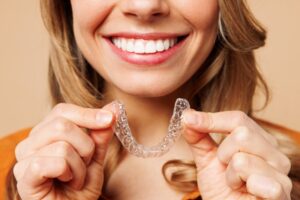
Invisalign has become a popular orthodontic solution for people who want to straighten their teeth without traditional metal braces. But many prospective patients wonder: Can Invisalign fix bite problems, or is it only for cosmetic straightening? Invisalign can fix many types of bite problems, depending on their complexity. With advanced technology and careful planning, Invisalign can help correct bite alignment issues and improve both the function and appearance of your smile.
Understanding Bite Problems
A “bite problem,” also known as a malocclusion, occurs when the upper and lower teeth don’t align properly when the jaws are closed. Common bite issues include:
- Overbite: When the upper front teeth overlap the lower front teeth too much
- Underbite: When the lower teeth extend in front of the upper teeth
- Crossbite: When some upper teeth sit inside the lower teeth rather than outside
- Open bite: When the upper and lower teeth don’t touch when the mouth is closed
- Crowding or spacing: Though not technically bite problems, these can impact how your bite functions
These issues can lead to more than just cosmetic concerns; they can cause jaw pain, uneven tooth wear, difficulty chewing, and even speech issues if left untreated.
How Invisalign Helps
Invisalign uses a series of custom-designed clear aligners that gradually move teeth into better alignment. With today’s digital scanning technology and 3D treatment planning, Invisalign can address many bite issues that were once only treatable with traditional braces.
Here’s how Invisalign tackles some common bite problems:
- Overbite: Invisalign aligners can gently reposition the upper front teeth and sometimes the lower teeth to reduce the overlap and create a healthier bite.
- Underbite: By shifting the lower teeth back and/or upper teeth forward, Invisalign can help align the arches more naturally.
- Crossbite: Invisalign can move individual teeth or groups of teeth outward or inward to correct the improper overlap.
- Open bite: Clear aligners can help close gaps between upper and lower teeth, especially when combined with attachments or elastics.
When Invisalign May Not Be Enough
While Invisalign works well for mild to moderate bite issues, more severe malocclusions or skeletal problems may require a different approach. Some complex cases may benefit from a combination of Invisalign and other orthodontic tools like rubber bands, expanders, or even jaw surgery in extreme situations.
The key is working with an experienced Invisalign provider who can assess your bite, review your X-rays and scans, and develop a treatment plan that meets your specific needs.
The Benefits of Correcting Bite Issues with Invisalign
- Improved oral health: A properly aligned bite reduces the risk of tooth wear, cavities, and gum disease.
- Better jaw comfort: Correcting bite misalignment can ease tension, headaches, and TMJ discomfort.
- Enhanced aesthetics: Invisalign not only improves your bite but also helps create a straighter, more confident smile.
- Discreet treatment: You can achieve all of this without visible braces.
Yes, Invisalign can fix many types of bite problems, safely, effectively, and discreetly. If you’ve been putting off treatment because you didn’t want metal braces, Invisalign may be the ideal solution.
About the Practice
Looking for a solution to your crooked smile? You’ve come to the right place! Aesthetic & Family Dentistry of Washington has an experienced team of dental professionals that can outfit you with Invisalign treatment. With these clear aligners, you can get a discreet fix to your oral issues, whether it’s just misaligned teeth or bite problems. Ready to put an end to your oral issues? Schedule an appointment online or call (202) 364-8989.
